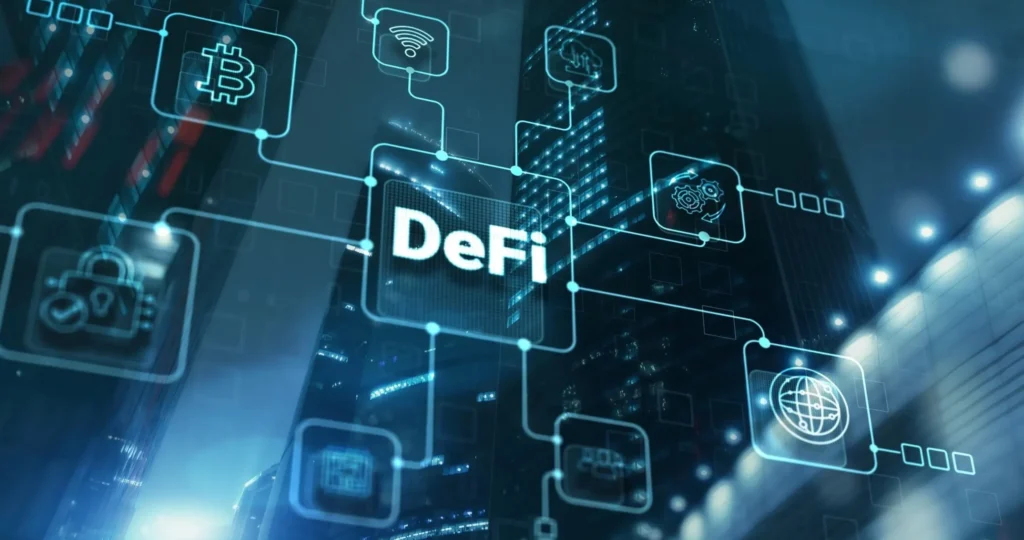With total value locked (TVL) hitting fresh benchmarks, the distributed finance (DeFi) ecosystem has notably expanded over the past year. Among the most popular DeFi platforms are Aave and Lido; Aave leads, and Lido is not far behind. Solana has also made a remarkable comeback, placing second on DeFi TVL and indicating a change in the landscape of public chains. This paper investigates the elements influencing these changes and how they will affect the direction of DeFi.
DeFi Market Leaders
Having topped $70 billion in combined TVL, Aave and Lido have confirmed their status as the DeFi heavyweights as of late 2024. While Lido, which promotes distributed staking, closely follows a TVL of around $33 billion, Aave, with a TVL of about $34 billion, has kept its leadership in the loan market. These two protocols, together, account for more than 70% of the total TVL locked in the top DeFi apps.
Aave’s DeFi Growth
Offering consumers the chance to earn interest on deposits and borrow assets against security, Aave has become a major participant in the DeFi lending industry. Aave’s multi-chain support across Ethereum, Polygon, and Avalanche, among other blockchain ecosystems, has improved its scalability and accessibility, attracting a sizable user base.
Aave’s TVL rose significantly in 2024, surpassing its highest level during the DeFi Summer of 2021. The platform’s continuous innovations—including the launch of Aave V3, which seeks to increase capital efficiency and liquidity management—help explain this development. Aave’s spread into non-EVM environments will likely increase its appeal and draw fresh users.
The release of the GHO stablecoin, meant to rival existing stablecoins on the market, offers one of the most exciting developments for Ave. This action, and the forthcoming Aave V4 update with dynamic interest rates and liquidity premiums, set Aave up for ongoing expansion and leadership in the DeFi market.
Lido’s Staking Success
Lido’s decentralized staking services, especially for Ethereum and other major blockchains like Polygon, have driven its success. By offering staked versions of tokens such as steth and stmatic, Lido has enabled users to earn staking rewards while maintaining liquidity, a unique proposition that has made it highly popular.
In 2024, Lido’s TVL grew significantly, reaching around $30 billion, with Ethereum staking playing a central role in its success. Lido has also broadened its offerings, allowing users to stake various tokens across different networks. Integrating Lido’s staked tokens into various DeFi protocols further enhances its utility, solidifying its position as one of the most influential platforms in the DeFi space.
Solana’s DeFi Comeback
Rising as the second-largest public blockchain in DeFi TVL, Solana had a fantastic comeback and expansion in 2024, surpassing systems like Tron. Growing interest in Solana-based projects and the emergence of distributed exchanges (DEXs) and perpetual markets built on Solana help explain this comeback somewhat.
After just a few months, Solana’s TVL soared to an astounding $8.6 billion at the end of Q4 2024, a 64% rise. Built on Solana, Raydium, a DEX, has grown significantly, which helps Solana expand DeFi. Furthermore, distributed perpetual trading systems like Jupiter Perps are drawing more users to the Solana ecosystem.
Solana’s DeFi Growth
Several elements have helped Solana’s quick ascent in the DeFi scene:
Solana-based DEXs, such as Raydium, have grown somewhat decentralized, with an 86% quarter-over-quarter increase. Raydium now ranks as Solana’s top DeFi protocol.
Platforms like Jupiter Perps have seen a 130% quarter-over-quarter rise in TVL driven by demand for distributed perpetual contracts.
The influx of memecoins and tokens associated with emerging technologies, particularly artificial intelligence (AI), has significantly fueled Solana’s DeFi expansion.
Solana has begun integrating AI-driven agents into its ecosystem to enhance user experience and optimize yield farming, governance, and other DeFi operations.
Driven by initiatives like Pump.Fun and Funoton, which drew significant volumes of speculative capital, Solana’s app revenue jumped 213% in Q4 2024. This—this vision emphasises Solana’s capacity to draw more traders and developers to its ecosystem.
DeFi Innovation and Growth
Rising Aave, Lido, and Solana symbolise a rising DeFi industry distinguished by greater competitiveness, creativity, and user involvement. These changes have significant ramifications for distributed finance’s future direction.
Capital Efficiency and Innovation
Aave’s attention to enhancing capital efficiency through Aave V4 and Lido’s development into new blockchains highlights the increasing need for the best use of resources in DeFi. These developments will probably improve user returns and guarantee more liquidity in DeFi markets.
Interoperability and User-Centric Development
Solana’s expansion is another piece of evidence of the DeFi space’s rising value of interoperability. Solana is a key participant in a multi-chain DeFi ecosystem since it offers low transaction costs and excellent throughput, enabling flawless cross-chain transactions.
Furthermore, including artificial intelligence in Solana’s system shows a general tendency toward user-centric innovations. AI-driven technologies let users interact with the ecosystem more straightforwardly, through eFi procedures.
Final thoughts
Significant inventions and expansions define the DeFi sector of 2024. While Solana’s ascent to the second-largest public blockchain by DeFi indicates a more general change in the field, Aave and Lido have become the most often-used protocols in terms of TVL. The future of DeFi looks better than ever, with continuous technological improvements and growing attention to user experience.




